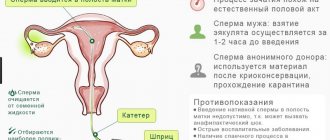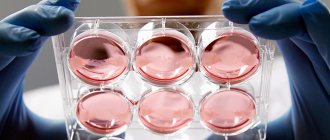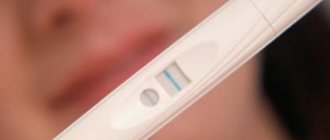Embryological stage of the IVF procedure
The embryological stage is one of the most important in the in vitro fertilization protocol.
The success of the entire therapy depends on the correctness of its implementation and compliance with all conditions. To cultivate embryos after IVF, it is necessary to create optimal conditions of humidity, temperature and gas composition, reminiscent of the natural environment of the female body. The embryological stage consists of preparing eggs and sperm for the fertilization process. To do this, approximately 100,000 sperm are added to a special medium per egg and placed in an incubator that automatically maintains optimal conditions. After a day, the results are evaluated and the best quality zygotes are selected. If the male factor plays a role in infertility, then it is recommended to perform the ICSI (IMSI) procedure, which consists of introducing a specially selected sperm into the cytoplasm of the egg.
Embryo cultivation
With IVF, fertilization is carried out under the supervision of doctors in special conditions that simulate the internal environment of the female body. You can observe this through a microscope to assess the quality of the developing embryos and divide them into categories.
Stages of formation of the unborn child from the moment of conception:
- Zygote (second day after fertilization).
- Morula (third day).
- Blastocyst (fifth day).
- Gastrula (sixth-seventh day).
- Embryo 9 (two weeks later).
- Full fruit.
A full-fledged fetus is formed from 8 weeks. An ultrasound will already be able to determine the baby’s heartbeat. By this time, the child’s central nervous system has already been formed. This is preceded by many periods of embryonic development. Every day is a certain stage and at each of them important transformations occur.
Transfer to the uterine cavity occurs approximately on the third or fourth day, or on the fifth or sixth at the blastocyst stage. The exact timing is determined by the individual characteristics of the woman’s body. Of all the embryos, the highest quality ones are selected.
The choice is influenced by factors such as shape and size, the number of blastomeres (cells into which the embryo is fragmented). There are actually more criteria, but these are the most important. How correctly the embryo will develop depends on the set of chromosomes inherited from the parents.
Development of embryos after IVF by day
The period of ovarian puncture and sperm collection is considered day zero. The countdown begins after the germ cells are placed in a special environment. 16 hours after mixing the gametes, you can observe the results of fertilization and see the zygote - an oocyte with a female and male nucleus. She has a diploid set of chromosomes with the genotype received from her parents.
On the second day, the embryo after IVF begins division, its cells are called blastomeres, there should be 2-4 of them.
On day 3, the embryo already has 6-8 blastomeres. This is a critical period in the development of the embryo: if it has genetic defects, then further development stops and it dies. This is due to the fact that the first days after conception, the embryo uses the nutrients and energy of the egg, but then its own mechanisms must turn on.
On day 4, the embryo after IVF consists of 10-16 blastomeres, the morula stage begins. Under natural conditions, at this time the embryo enters the uterine cavity from the fallopian tube. At the end of the day, a cavity is formed inside the morula, and the cells are divided into 2 groups. When the cavity occupies more than half of the volume, the morula becomes a blastocyst.
On days 5-6, the embryo after IVF is completely ready for implantation, so experts recommend cultivating embryos until this period. But it is worth noting that in an artificial environment, not all embryos survive up to 6 days. The cavity of the blastocyst gradually increases, which leads to thinning of the membrane, its rupture and the release of a formed embryo, ready for implantation into the endometrium. This process is called hatching; if the membrane is too dense and the embryo cannot escape on its own, assisted hatching is used.
At this stage, it is possible to select embryos of the highest quality, as well as conduct their pre-implantation diagnostics in order to determine the genotype.
On the 7th day, the embryo after IVF is in the uterine cavity and begins to sink into the endometrium. The placenta is subsequently formed from the external cells, and the tissues and organs of the baby from the internal ones.
On day 8, the outer layer of surface cells forms trophoblast villi, which provide nutrition to the embryo and oxygen supply. At this stage, the embryo is called a gastrula.
On day 9, the embryo moves deeper into the endometrium, and implantation bleeding may develop due to vascular damage. On the 10th day, the implantation process is completely completed and the placenta begins to form. On day 11, placental cells begin to synthesize hCG. On days 13-14, the concentration of hCG in the blood is sufficient to determine the fact of pregnancy.
Reasons for unsuccessful procedures
The embryo continues its development inside the mother's body after replantation. The success of this process is influenced by many factors. In their absence, no problems arise, but in the presence of genetic disorders, the chances of maintaining the pregnancy are negligible. The woman’s body simply rejects the implanted embryo and a miscarriage occurs.
Other reasons why the embryo does not develop in the uterus after transfer:
- Hormonal disorders in a woman's body.
- Unreadiness of the endometrium to accept a foreign body.
- Stressful situations.
- Immune system disorders.
- Inflammatory processes in the uterine cavity.
- Unfavorable conditions for embryo transfer.
To eliminate all possible risks, various examinations of future parents are carried out at the IVF planning stage. First of all, the health status of women and men is assessed and diseases of the reproductive organs are identified.
In addition, genetic testing of various levels is carried out. After all, congenital pathologies can manifest themselves not only immediately after the birth of a child, but also with age. Deviations in the chromosome set are also determined before embryo transfer using the method of preimplantation genetic diagnosis.
PGD of the embryo is performed using a biopsy. After conducting a genetic study, those that do not have prerequisites for genetic abnormalities in the unborn child are selected.
Embryo transfer after IVF
Embryo transfer after IVF is carried out mainly on days 5-6, since during this period they have a high chance of successful implantation. But if after ovarian stimulation few eggs were obtained, then embryo transfer after IVF is carried out on the 3rd day, while they are in a free state in the uterine cavity for 2 days (sometimes up to 10 days) and only then are implanted.
For transfer after IVF, embryos of the highest quality are selected according to certain criteria (number of cells, shape and size, absence of fragmentation, etc.) in order to prevent the development of intrauterine defects and anomalies, as well as to ensure maximum chances for successful implantation.
After embryo transfer
The development of embryos after transfer may differ slightly, depending on the age of the embryo and favorable circumstances for its development. Let's look at all the options for embryonic development after the IVF protocol is completed.
"Three days"
The zygote, which is the fertilized egg at this moment, consists of 6-8 cells. The zygotes are introduced into the uterus using a soft and flexible catheter through the cervical canal of the cervix. It is advisable to carry out replanting at the end of the third day, since it is during this period that the so-called “developmental block” often occurs - some of the embryos stop fragmenting and stop growing due to the presence of gross genomic abnormalities. It is the genome that “dictates” the rules of development. It contains all the information about which cells and how they should divide, and subsequently differentiate.
If the quality of the germ cells was high enough, the chances of obtaining embryos with a complete genome are higher. But even in the case of the fusion of completely healthy germ cells (a normal oocyte and a high-quality sperm), they do not guarantee that some genomic abnormalities will not arise during the fertilization process. That is why it is important for the embryologist to make sure that on the third day of development the embryo does not experience a “developmental block.”
It is possible that development will stop after the transfer, but in this case the reasons may be not so much genetic as physiological: the endometrium was not ready to accept the embryo, the woman’s hormonal background was not favorable enough and due to other factors.
So, the “three-day” ones were replanted. During the first 24 hours after transfer, embryos cannot consolidate even theoretically; they “float” freely in the uterine cavity. The embryonic period of their development continues. The embryo transfer procedure itself does not affect the embryo in any way if the procedure is carried out correctly. Zygotes are introduced into the uterus along with a small amount of the nutrient medium in which the cultivation took place.
The day after the transfer, the embryos in the uterus enter the morula stage. The shapes of the embryo become more even, the intercellular connections become more dense. At the end of the first day after the transfer, the morula has a hollow space inside and it expands.
A process begins, which in embryology is called “cavitation”: blastomere cells begin to separate into two parts. Each of the groups of cells will be assigned by nature its own mission, because very soon the intensive formation of organs and systems of the fetus will begin.
Embryo development after IVF transfer
After embryo transfer during IVF, there is a waiting period, since the specialists have done everything possible to achieve pregnancy, and nothing depends on the patient herself. Successful implantation and further development are possible due to adequate physiological processes and the formed genome of the embryo.
After embryo transfer during IVF, a number of unique mechanisms are launched:
- Biochemical: the synthesis of enzymes is activated, which actively destroy the endometrium during the engraftment process. After implantation, chorionic cells begin to synthesize hCG;
- Biophysical: growth of cellular volume, cell differentiation, strong intercellular connections, etc.;
- Trophic: the type of nutrition of the embryo changes (through the circulatory system of the maternal body);
- Formation of embryonic tissues and extraembryonic structures.
We trust nature
Women re-read tons of literature, trying to find those 5 dpo sensations
or
6 dpp sensations
that would indicate implantation and, accordingly, the onset of pregnancy.
Actually, expectant mothers start worrying whether it worked or not at 3 DPO
.
This question is equally of concern to girls who have undergone the IVF procedure. Estimated embryo implantation after IVF
They try to catch it by minimal changes in the body and well-being.
The Internet is replete with requests like “ 5 dpp of three days
”, “
4 dpp of five days”
, “
7 dpp of five days
”, with the help of which women look for positive stories.
The absence of even a hint of a second page on day 8
or
menstruation after embryo transfer
.
But in fact, the answer to the question of why the embryo does not take root
may be an objective situation of natural selection. The non-viable fetus was rejected, giving way to healthy offspring.
In fairness, it is worth noting that if such rejection is repeated constantly, then this is a reason for a full medical examination. The reason for the failure of a long-awaited pregnancy may also be male infertility.
Implantation is a critical point, because the blastocyte is perceived by the woman’s body as a foreign object due to the presence of male genes in the cell. The speedy and successful introduction into the endometrium and the onset of a normal healthy pregnancy depend on how well the defense mechanisms of this cell work.
The development of the embryo (the concept of a future child) takes place best in the mother's body. However, as part of the in vitro fertilization program, on what day the embryo is transferred to the uterus is determined individually in each individual case and depends on the quality of its development.
The day of collecting eggs from a woman’s body using a puncture is considered zero. On this day, fertilization of a mature egg with sperm is carried out using standard IVF or ICSI.
Recommendations after embryo transfer during IVF
After embryo transfer during IVF, the patient should follow a number of recommendations that should increase the chances of success:
- You should lie down and rest for an hour after the procedure;
- It is best to limit any physical activity for 10 days and avoid sports training;
- Spend more time outdoors;
- Avoid stressful situations;
- It is necessary to avoid sexual intercourse for several weeks;
- Adhere to a proper and healthy lifestyle: eat well, rest, give up bad habits, etc.
5-6th day of development
At the stage when the cavity inside the morula occupies half of its volume, the embryo is called a blastocyst. As a rule, the period of blastocyst formation occurs on the fifth day of development, but it is also possible on the fourth to sixth days.
Blastocyst cells are represented by two populations:
- single-layer epithelium that surrounds the cavity - trophoblast;
- internal dense lump of cell mass.
The trophoblast of the blastocyst is responsible for the process of implantation of the embryo into the endometrium (lining of the uterus). Subsequently, trophoblast cells will give rise to the extraembryonic membranes of the fetus. The inner cell mass will give rise to all the organs and tissues of the unborn child. The better developed the cells of the blastocyst and the larger its cavity, the higher the potential of the embryo for successful implantation into the uterine epithelium.
At the moment when the cavity of the blastocyst reaches a large size, the zona pellucida is depleted due to its stretching, and the process of hatching the embryo from the shell begins. Only after this stage is completed is the blastocyst ready for implantation. The implantation of the embryo into the endometrium occurs, as a rule, on the sixth or seventh day of its development.
Only after implantation has occurred and the embryo has successfully implanted in the uterus can we talk about pregnancy occurring as part of an in vitro fertilization program. In the future, doctors observe how the embryo develops during the weeks of pregnancy.
Pregnancy can occur only in cases where a healthy embryo is used for implantation. Conception will not occur if there is a failure at any stage of embryo development. In this case, the maternal body will reject it. Successful implantation also depends on the individual characteristics of each woman’s body and the influence of external environmental factors and internal factors of the body.
Feelings after embryo transfer during IVF
Most women do not experience any specific sensations after embryo transfer during IVF, and clinical signs may be caused by the use of hormonal drugs. Swelling of the mammary glands, pulling sensations in the lower abdomen, spotting, increased basal and body temperature, sleep disturbances, and mood swings cannot be ruled out.
If such subjective symptoms appear, you should not immediately judge the results of the procedure and perform a pregnancy test. It may be false positive due to the use of hCG drugs. Confirmation of the fact of pregnancy is carried out on the 14th day after embryo transfer during IVF by determining the level of hCG, and after 3 weeks - using ultrasound. Carrying out analyzes in the early stages is uninformative.
How to maintain pregnancy: support
The increased risk of miscarriage after in vitro fertilization can be due to a variety of reasons, including:
- infection and the onset of the inflammatory process;
- endocrine disorders;
- immunogenetic problems, in particular, incompatibility of the Human Leukocyte Antigen (HLA) gene between the father and mother of the child, especially class II, as well as other forms of chromosomal polymorphism in spouses;
- antiphospholipid syndrome (APS);
- the presence of antibodies to hCG in the woman’s blood.
Most often, the reason for the loss of a long-awaited baby during pregnancy after IVF is hormonal disorders in a woman’s body, so many clinics practice a course of hormonal support for the patient, for which a blood test for estradiol is carried out over time (on the day of transvaginal puncture of the ovarian follicles, on the fifth day after replantation and in another 3-4 days).
Did you know? According to statistical studies, out of ten pregnancies after in vitro fertilization, three to four end in miscarriage during the first trimester.
Depending on the results, the patient is prescribed according to a certain scheme:
- Fragmin (anticoagulant);
- Utrozhestan, Crinon, Proginova, etc. (special hormonal drugs for the prevention of miscarriage).
Of course, the specific reason why there is a threat of termination of pregnancy must be determined by the doctor. He also decides what measures should be taken to prevent a tragic outcome. There can be no talk of any self-medication in this case, so we will not describe possible methods of therapy.
Only two things are required from a woman:
- Strictly follow all doctor’s recommendations and general rules of conduct for expectant mothers, including those described above.
- Carefully listen to the signals of your body and immediately inform the doctor about any, even the most minor, changes and deviations.
During multiple pregnancies, the importance of following these rules increases to critical importance.
Signals to immediately contact a doctor are, in particular:
- stomach ache;
- any discharge, not necessarily bloody;
- increased body temperature;
- change in basal temperature, especially downward;
- headaches, etc.
Stopping embryo development after IVF: possible reasons
Sometimes the patient may not wait for the embryo transfer after IVF, since they have stopped dividing and developing. According to statistics, 10-15% of embryos stop the division process at the stage of 2-4 cells (on day 2). Stopping division is a natural selection process that prevents the appearance of an infant with genetic defects.
Reasons for the cessation of embryo development after IVF:
- Suboptimal cultivation environment;
- Genetic abnormalities;
- Inability to activate the embryo's genome for further development;
- Cell defects, etc.
There are many reasons for the cessation or absence of embryo development after IVF, but the main one is a genetic abnormality. It can appear at the zygote stage, on the 3rd day, after transplantation or after implantation.
Specialists at the IVF Center clinic in Smolensk conduct a thorough diagnosis of the condition of embryos at all stages of IVF, which allows them to obtain the best results from this procedure.
Implantation
It is impossible to say in advance on what day the blastocyst will be implanted. This stage of embryo development allows it to immediately penetrate the uterine mucosa. On average, attachment occurs 2-5 days after transfer.
When transferring three-day-old embryos, the embryo can be implanted on days 7-10. Attachment is preceded by “wandering” of cells throughout the uterus for 3-7 days.
Women sometimes notice changes during implantation after IVF - nagging pain in the lower abdomen, beige discharge from the genital tract (they may not exist). After a few days, the first signs of pregnancy may appear. Often they turn out to be far-fetched and become the result of self-hypnosis.











